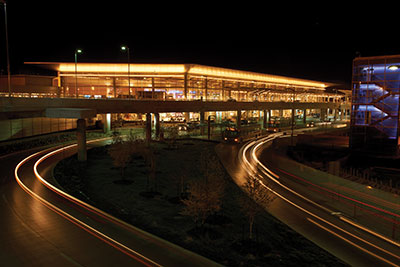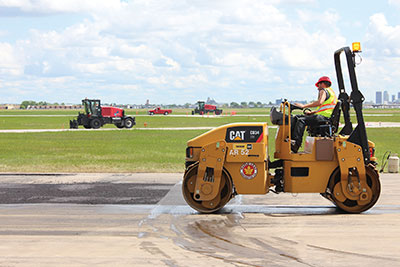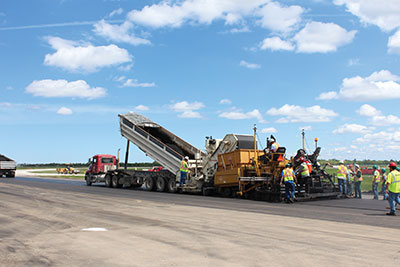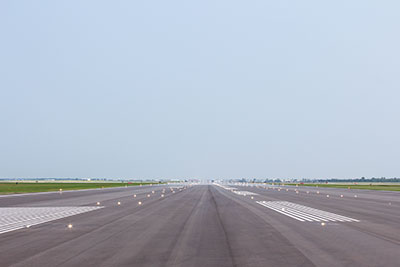
Features
Projects
Roads & Paving
Runway in Rehab
Resurfacing an airport runway is a special project
November 27, 2014 By Carroll McCormick
With aircraft all around, airport security tight, intricate paving
specifications and regulations galore to follow, resurfacing a
3,353-metre runway at the Winnipeg Richardson International Airport this
year was an exercise in strict attention to the details.
With aircraft all around, airport security tight, intricate paving specifications and regulations galore to follow, resurfacing a 3,353-metre runway at the Winnipeg Richardson International Airport this year was an exercise in strict attention to the details.

|
|
The Winnipeg airport has two crossing runways. Runway 18/36 is 3,353 metres long and 61 metres wide. Runway 13/31 is 2,652 metres long and 61 metres wide. Last paved in 2003, Runway 18/36 required resurfacing and extensive work on its lighting system. The Winnipeg Airport Authority (WAA) shut down Runway 18/36 for 14 weeks starting on April 18 for $8.2 million in repairs.
“The pavement resurfacing was primarily to address typical pavement deterioration and wear, and weathering of the aircraft operating area’s 61-metre width. The work addressed significant weathering and crack deterioration in the asphalt pavement, bump repairs and surface grading/drainage improvements. The two-metre paved shoulders were resurfaced, where required, for paving tie-in and finish grading adjustments,” explains Andrew Curwin, project engineer, WAA.
The work included removing and replacing 400 inset lights, milling down the runway an average of 90 millimetres, laying down 55,000 tonnes of hot mix asphalt concrete (HMAC) and doing some land drainage sewer repairs. Contractors carried out all of the work while the airport maintained its full schedule of flights, using Runway 13/31. Maple Leaf Construction Ltd. was the general contractor.
Safety and security are big concerns when work crews are brought into airports. The regulations are less onerous for landside work, that is, access roads, parking lots and the areas inside the terminal before the passenger screening areas where luggage is X-rayed, shoes and belts come off and pockets are turned inside out. On the airside, however, and especially out on the airfield, safety is a huge deal and security is tight.
WAA issued restricted area identification cards to everyone working on the project. It retained Regina-based Avion Services Corp. to staff the access control gates, where they checked each passing worker’s ID. WAA called back airfield winter seasonal maintenance workers to act as vehicle escorts for the work crews once inside the gates. All this was carried out in accordance with the WAA Airport Traffic Directives and Airside Vehicle Operator Permit Program and Transport Canada security regulations.

|
|
| Nearing the edge of the Winnipeg airport’s 61-metre wide Runway 18/36. (WAA)
|
Runway incursions, which are when any person, vehicle or aircraft wanders too near or onto an active runway without permission, are very serious incidents. Workers were not permitted to cross Runway 13/31, and one of the purposes of the escorts was to make sure no one strayed out of the specified work areas.
WAA developed a Plan of Construction Operations, in consultation with Transport Canada, Nav Canada, which controls all aircraft on the ground and in the air, the Department of National Defence, which has its Canadian Forces Base Winnipeg at the airport, airlines, air cargo operators and others. “Staging and work restrictions were identified to accommodate the work and maintain safety of aircraft operations at all times,” Curwin says.
With all these procedures in place, the work began. Crews laboured from 5:30 am to 9:00 pm every day, with some exceptions for weather. “The work was split into four major work areas, with specific sub staging and scheduling constraints for intersection work at Runway 13/31, and the intersections at taxiways K, P and C to accommodate ongoing operations,” Curwin explains.
Before the milling and paving could begin, though, crews removed the 219 runway centerline lights. They also removed the 180 touchdown zone fixtures, which are arranged in 30 bars on the Runway 36 end. The contractor worked around the runway edge lights without removing them by sleeving over them with PVC pipe and paving around them. WAA airfield electrical staff later re-adjusted the fixtures to grade and levelled them.
The contractor milled down the runway an average of 90 millimetres, with the milling depth varying from 45 to 100 millimetres. It then resurfaced the runway with two 50-millimetre lifts of HMAC.
As WAA had already paved the intersection of Runways 18/36 and 13/31 in 2011, it was able to avoid the intricacies of staging that work while maintaining an active runway.
Aircraft put tremendous loads on runways, particularly on departure. A fully fuelled Boeing 747-300 weighs around 377,800 kilograms. An Airbus 310-300 might weigh 157,000 kilograms on takeoff. The gargantuan Airbus A380, for which Winnipeg is an alternate, that is, an airport pre-selected for emergency landings along a route, can weigh 544,300 kilograms on takeoff.
Transport Canada specifies that, “A runway should be capable of withstanding the traffic of aeroplanes the runway is intended to serve.” The specifications behind this helpful statement are complex, but suffice to say that at the Winnipeg airport this translates into a pavement structure on Runway 18/36 that is no less than 980 millimetres thick.
 |
|
| The contractor worked to strict Transport Canada guidelines to provide a surface that drains well and is safe and strong for high-weight, high-speed aircraft. (WAA)
|
The resurfacing project replaced roughly one-tenth of the runway’s thickness, and the asphalt mix was just a bit special, says Curwin. “It is similar to roadway mix designs [but] with some specific differences in material properties specified, including no recycled content, tighter aggregate specifications, higher minimum asphalt binder content, higher required compaction and stability values.
“The specified asphalt mix design was for all virgin source aggregates, for higher control and quality of mix design. A small amount of asphalt milling material was used for topping on a construction access road, but the majority was removed from site by contractor and recycled for use in asphalt mix for municipal road and parking lot works.”
The asphalt quality control included continuous daily material testing by the contractor and WAA, using independent testing laboratories.
The contractor declined to discuss the paving equipment it used, but, Curwin notes, the items WAA specified, such as specified paver machines for finished grading control and auto transfer, are typical of large paving projects. “A typical setup for paving machines with automatic grading control [included] two receivers on the paver, nine total station survey guns and a full-time contractor survey crew of six to monitor and control.”
Transport Canada is very specific about the amount of slope that runways must have, both longitudinally and in the transverse direction. There are camber rules as well, and no runway would ever have the truck tire-grabbing dips found on highways.
 |
|
| Runway 18/36 at the Winnipeg Int'l Airport: resurfaced and opened for business. (WAA)
|
For example, depending on the airport code letter, the transverse slope that Transport Canada specifies may be 1.5 degrees or 2 degrees. To meet the agency’s strict standards the contractor and WAA maintained full-time survey crews and inspectors to monitor quality control.
The land drainage sewer repairs included filling two drainage crossings under the runway with concrete and installing two new land drainage pipes.
Some runways are grooved or scored to achieve a certain friction value and reduce hydroplaning. The contractor did neither on Runway 18/36, but a consultant comes in once a year to do friction tests in accordance with Transport Canada regulations for friction testing guidelines.
On July 31, WAA declared the rehabilitation of runway 18/36 complete and announced to aviators that it was once more in service.
Print this page